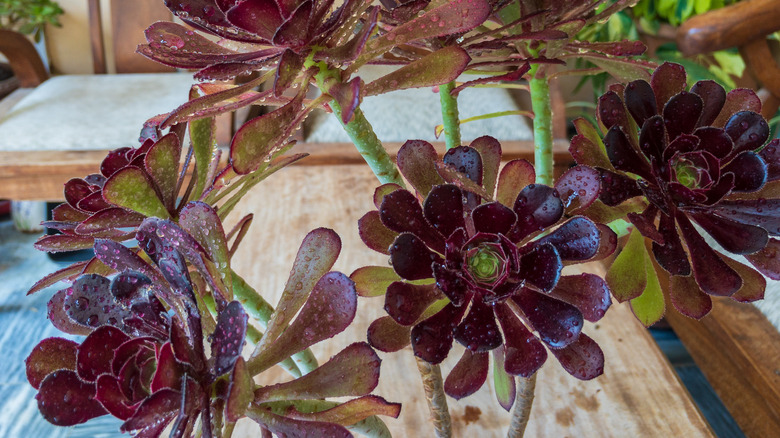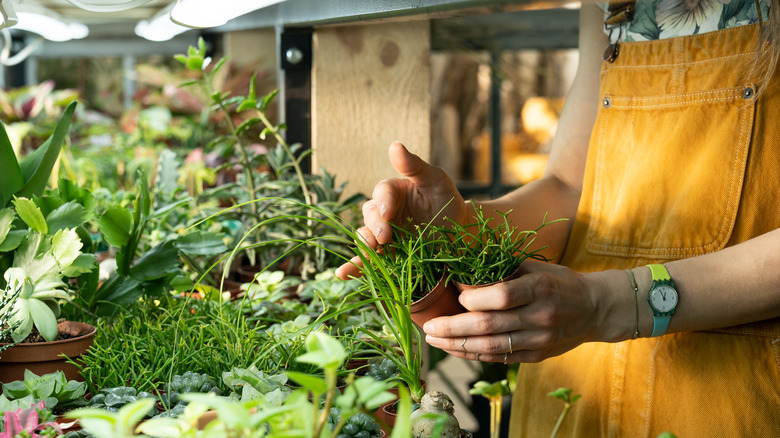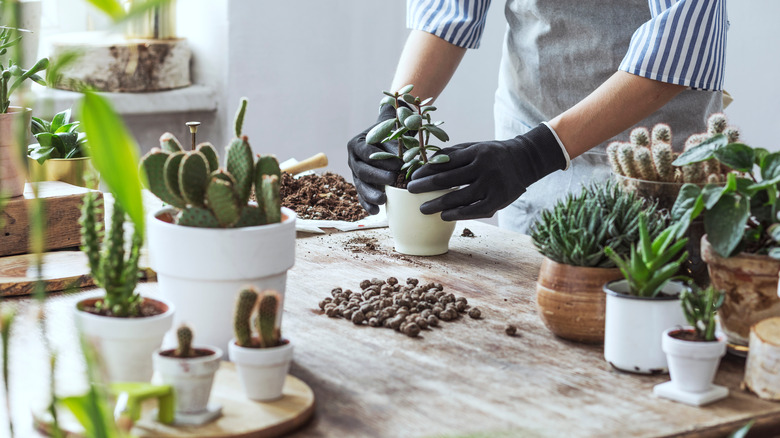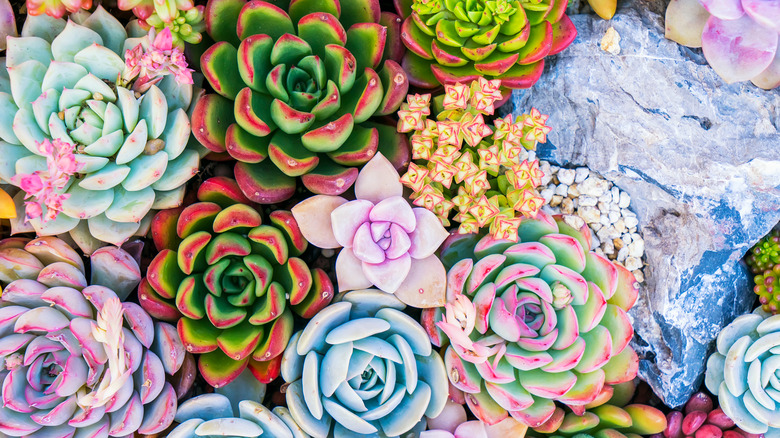How To Create A Succulent Garden On Your Patio
Do you like plants, but lack the ambition to become a constant gardener? Well, unlike the title character of John le Carré's 2001 novel "The Constant Gardener," you could become an occasional gardener and still achieve spectacular results — by growing a patio or balcony garden of succulents.
With tongue planted firmly in cheek, Succulent Plant Care confides that when it comes to growing succulents, they can continue to thrive while you're busy ignoring them. So whether you're looking for plant life that's low-maintenance or you're just experimenting with the idea of gardening and want to see what it feels like to try on a gardening routine, succulents are definitely among the most forgiving of plants.
A word about semantics here: All cacti are succulents, but not all succulents are cacti. Somewhere along the line, they became conflated, but in truth, succulents are what they are and belong grouped together because of their ability to hold onto moisture. Merriam-Webster defines succulents as pulpy, juicy fleshy plants which share the identifying characteristic of water retention. These include everything from aloe and agave plants to a wide variety of cacti. The main advantage you have as a gardener growing succulents is that if you forget to water, or fertilize, or get a ballpark idea of how much sun your balcony or patio gets, you're still going to have a garden that makes you look as though you knew pretty much what you were doing all along.
Why grow a succulent garden on your patio
Yards landscaped entirely from rocks and cacti became popular starting in the '80s (via the Los Angeles Times) — particularly in the Southwest amid the explosion of ranch-style homes. Admittedly, they were among the easiest to maintain (you can break a rock, but you sure can't kill one. And cacti are nearly as indestructible). But they also carried some stigma as a telltale sign of sloth. If you weren't sweating behind a lawn mower on Saturday by 10 a.m. — well, what kind of neighbor were you, anyway?
Eventually the children of those tract homes grew up to have kids of their own, who had their own offspring in turn. Now, the stigma is gone, and many of those former youngsters live in high rises, condos, and duplexes and know full well the advantages of succulent gardening.
According to HomeBNC, such gardens have never been more popular. These days you'll find them in offices, poolside, on patios and balconies. They're often described as the camels of the plant world because their need for water — and therefore attention — is so low. Many of these plants thrive when watered no more than twice a week. And guess what? In the winter months, you can actually cut back. They don't require much room as they mature, and as many gardeners know, there are dozens to choose from that give keep you hours of enjoyment, as well as curb appeal from the street outside.
How to start a succulent garden on your patio
As we mentioned earlier, there's been some confusion over the decades about succulents and cacti. And because that's so, the idea of a small balcony or patio with army green plants bristling with needles doesn't always do a great job of selling a garden full of them — especially in a confined area.
Once you've decided to grow succulents, assess the spot where you plan to raise them. Then decide how many plants you'll want to tend and how you intend to keep them. Each one requires its own habitat, of course. Pots come in a variety of sizes and shapes, from the heavy (and often beautiful) ceramic, to fabric grow bags that don't weigh much more than the soil inside. Make sure your patio or balcony can support the added weight you're putting on them, and remember: You can also suspend many of these plants from the ceiling. Shallow shelves can take the place of a trellis or latticework and keep your plants from taking up every available inch of floorspace as well.
Pick wisely, Facty recommends, because both watering and drainage are essential elements to plant health. Using a mixture of rocks, gravel, and cactus potting soil will ensure that your succulents don't become waterlogged — among the greatest dangers to their survival. Placing pans beneath your plants is a nice way to make sure it's your plants that are getting watered and not your downstairs neighbors.
Popular garden succulents
To the outside world before 1980, succulents were backdrops in old Westerns and satirized in Roadrunner cartoons. Now, and especially with the advent of the internet, gardeners have come to see that there is truly an amazing diversity among these plants — and many of them are among the hardiest in nature (via The Ringer).
So, when it comes to planting succulents on the patio or balcony, what do the experts recommend? The florists at FTD have nearly a dozen to start you on your path. Their one caveat: be aware of how much sun and heat your grow space gets. And be advised that just because your plant instructions say a plant can handle one doesn't necessarily mean they can cope with both. Among their picks:
•The Torch Plant (aloe aristata), which blooms in fire-resembling orange blossoms
• Hens-and-Chicks (sempervivum tectorum), which reproduces nearly overnight and boasts some 3,000 varieties
• Sunburst (aeonium davidbramwellii), renowned for the yellow leaves that protrude from their center, creating a pinwheel effect
• Stonecrop (sedum spp.) appears in an assortment of colors that range from pink to green, blue, and silver
• Whale's Tongue (agave ovatifolia) is immediately recognizable by its flat and wide green leaves that resemble a whale's tongue
• Zwartkop (aeonium arboreum) is also known colloquially as the black rose because of the deep burgundy hue of its leaves
• Ball Cactus (parodia magnifica) is a definite eye-catcher, since its appearance resembles a steampunk air balloon — round with spiky thorns



